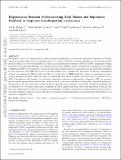| dc.contributor.author | Burger, Jan D. | |
| dc.contributor.author | Zavala, Jesús | |
| dc.contributor.author | Sales, Laura V. | |
| dc.contributor.author | Vogelsberger, Mark | |
| dc.contributor.author | Marinacci, Federico | |
| dc.contributor.author | Torrey, Paul A. | |
| dc.date.accessioned | 2022-08-18T16:38:50Z | |
| dc.date.available | 2022-05-06T14:58:39Z | |
| dc.date.available | 2022-08-18T16:38:50Z | |
| dc.date.issued | 2022-04 | |
| dc.identifier.uri | https://hdl.handle.net/1721.1/142385.2 | |
| dc.description.abstract | Abstract
We present a suite of 16 high-resolution hydrodynamic simulations of an isolated dwarf galaxy (gaseous and stellar disk plus a stellar bulge) within an initially cuspy dark matter (DM) halo, including self-interactions between the DM particles (SIDM); as well as stochastic star formation and subsequent supernova feedback (SNF), implemented using the stellar feedback model SMUGGLE. The simulations start from identical initial conditions and we regulate the strength of SIDM and SNF by systematically varying the SIDM momentum transfer cross-section and the gas density threshold for star formation. The DM halo forms a constant density core of similar size and shape for several combinations of those two parameters. Haloes with cores that are formed due to SIDM (adiabatic cusp-core transformation) have velocity dispersion profiles which are closer to isothermal than those of haloes with cores that are formed due to SNF in simulations with bursty star formation (impulsive cusp-core transformation). Impulsive SNF can generate positive stellar age gradients and increase random motion in the gas at the centre of the galaxy. Simulated galaxies in haloes with cores that were formed adiabatically are spatially more extended, with stellar metallicity gradients that are shallower (at late times) than those of galaxies in other simulations. Such observable properties of the gas and the stars, which indicate either an adiabatic or an impulsive evolution of the gravitational potential, may be used to determine whether observed cores in DM haloes are formed through self-interactions between the DM particles or in response to impulsive SNF. | en_US |
| dc.language.iso | en | |
| dc.publisher | Oxford University Press (OUP) | en_US |
| dc.relation.isversionof | 10.1093/mnras/stac994 | en_US |
| dc.rights | Attribution-NonCommercial-ShareAlike 4.0 International | en_US |
| dc.rights.uri | https://creativecommons.org/licenses/by-nc-sa/4.0/ | en_US |
| dc.source | arXiv | en_US |
| dc.title | Degeneracies between self-interacting dark matter and supernova feedback as cusp-core transformation mechanisms | en_US |
| dc.type | Article | en_US |
| dc.identifier.citation | Burger, Jan D, Zavala, Jesús, Sales, Laura V, Vogelsberger, Mark, Marinacci, Federico et al. "Degeneracies between self-interacting dark matter and supernova feedback as cusp-core transformation mechanisms." Monthly Notices of the Royal Astronomical Society. | en_US |
| dc.contributor.department | MIT Kavli Institute for Astrophysics and Space Research | en_US |
| dc.relation.journal | Monthly Notices of the Royal Astronomical Society | en_US |
| dc.eprint.version | Author's final manuscript | en_US |
| dc.type.uri | http://purl.org/eprint/type/JournalArticle | en_US |
| eprint.status | http://purl.org/eprint/status/PeerReviewed | en_US |
| dc.date.updated | 2022-05-06T14:48:59Z | |
| dspace.orderedauthors | Burger, JD; Zavala, J; Sales, LV; Vogelsberger, M; Marinacci, F; Torrey, P | en_US |
| dspace.date.submission | 2022-05-06T14:49:03Z | |
| mit.license | OPEN_ACCESS_POLICY | |
| mit.metadata.status | Publication Information Needed | en_US |
